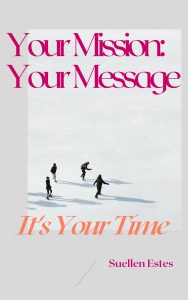
by Suellen | Successful Living
“One of the greatest labor-saving inventions of today is tomorrow.”
— Vincent T. Foss
There are tons of jokes about procrastination, and for good reason: it’s such a common human frailty. We’ve all heard from our teachers and mentors how important it is not to procrastinate.
Start your work early.
When you see what to do, just do it!!
Never put off until tomorrow what you can do today.
Okay! Okay! You say. (And I do too).
So I have that tendency. What’s the big deal?
Well, if you and I want to live our lives with a low level “spinning our wheels” mentality, then it really isn’t such a big deal.
We can just put things off. Make sure that we pay our bills on time so nothing will get turned off or reclaimed. The rest is okay.
Of course, since nothing ever stays the same, there will be a steady decline in the things we are avoiding. If it’s healthy eating or exercise, the pounds will slide up – along with blood pressure.
If we are avoiding tackling those job skills which would bring some increase, then we will notice a downward trend.
If we put off getting with our friends and family, our relationships will suffer.
But it’s our life and it’s our choice.
Now when I think about procrastination in those terms, I realize that I do want to improve in that area. I just have this one life, and I want to live it to the absolute fullest.
So let’s do some digging…
Why Do we Procrastinate?
Confusion and Overwhelm
The number one reason is Confusion. Or overwhelm. We aren’t sure what to do, so we do nothing.
There are so many choices for diets – or business models – or ways to budget, we put off making a decision. How do we know which one is the right one?
My answer for this is to set aside some time and determine to make a decision. You may want to read some articles or books by people who are knowledgeable. Also you want to do some soul searching.
Think hard about what you really desire. What are your skills and how do they match your desires? What other commitments do you have – to family, church, etc? How do these commitments affect your decision?
Then it’s decision time. Make a decision and stick to it. Commit to yourself that you are going to hold firm to this commitment for maybe six months. You might make some adjustments, but don’t throw it out completely during that time.
For the next six months, block off chunks of the big commitment, and work through those.
Each step will bring you closer to your goal.
Perfectionism
The second reason is perfectionism.
I really hate to be the one to break this news to you, but you are not perfect. That’s the bad news. The good news is that neither is anyone else. So you are not alone.
This is something which I have had to battle. When I am making plans and carrying them out, they never seem to be the perfect plans I envisioned.
My website isn’t perfect. Neither is my writing. Or my graphics. Or my email schedule.
So as I am busily trying to perfect these things, I notice someone to my left who is skidding past me as if they were on an electric sidewalk. And they aren’t perfect either!
As I began to take notice, I realized that the important thing was to start. If we will make a decision on our plans and then begin, we can make adjustments and corrections along the way.
There will be times when we will throw out the whole plan and redirect. But not right away. Give it six months.
Dread
The third reason is dread
Dread of what? Dread of failure…Maybe it’s too hard.
Dread of doing something you don’t enjoy.
Dread of possibly looking foolish.
List the things which you delay on a routine basis. Often those are the very things which are not comfortable.
Starting that eating plan. Cleaning out a closet. Going to the Doctor. Writing that email.
So How Do We Slay this Beast?
Well, just like anything else, your success starts with a decision.
- Decide that you won’t allow procrastination to stand in the way of you and success. You are going to subdue this beast.
- Then make a list of the things which you have delayed. Analyze why you avoid those particular actions. Was it Overwhelm? Confusion? Perfectionism? Dread?
- Whatever the cause, determine that you are going to face the giant. It might not be perfect, but that’s O.K. Remember: an item marked “Done,” is better than an item marked “in process-becoming perfect.”
- Put a big sign on your bulletin board that says, “No More Delay.”
- Then go down your list, checking off the items.
Oh, that feels good. Doesn’t it?
No more delay.
Let’s get started!

by Suellen | Write Your Own Book
There’s just Not Enough Time!
I have to say, this has been my lament in many situations.
Of course, we know the adage that “everyone has the same 24 hours.” But that adage didn’t make any difference when I was attempting to get more done.
With a church to oversee. Children and grandchildren. Serving on City Council. Other community activities. And on and on.
Then I read Stephen Covey’s book again. 7 Habits of Highly Effective People.
Do you remember the chapter about the rocks in a jar?
First, you have a pile of rocks of many different sizes and you fill the jar the best way you can. Many rocks get left out. They just won’t fit. There’s not enough room.
Then you try a different approach.
You put in the big rocks first. Then the middle sized ones. Finally you can fill in the crevices with the tiny rocks and pebbles.
Covey was linking this demonstration with time management. There are those big things, which require most of our time. The nine-to-five job. The running of the house. Childcare. Church work. Daily devotions.
Next come the middle sized time demands. Personal care. Doctor and dentist appointments. Volunteering at your child’s school carnival.
Then there are those little items. Leave dog at vet. Drop off cleaning. Write a quick note to teacher. You know those tiny time consumers which can overwhelm your day if you let them.
So Covey recommends that you take out your calendar and insert the large items first. Then the middle-sized. After those bigger plans are marked out on your calendar, it will be surprising how much vacant space you will see.
This Covey suggestion is what I like to use.
All those tiny time consumers can be put on a list. You have 10 minutes while you are waiting for your child? Pull out an item from your list and whip it off quickly. A phone call. A note. Paying a bill. Making a grocery list or planning a meal.
It’s amazing what can be done with proper planning.
But this is the best part: When you plan your time in this way, there will still be some blank spots on your calendar.
Those are the times you can use to take on some long term projects. Those things you don’t think you have time for right now.
That, in fact is how I wrote and published my first book.
After years of feeling inadequate and too busy to write, I marked my calendar and found some time. Maybe an hour here. Two hours there.
It’s amazing what concentration and commitment will do for us.
Those smaller moments add up, and soon the project is completed. That “wow” moment when it’s done!
The excitement of completing that first book was worth all of the effort I had put into finding the time. All of the organization and planning. That first book was worth whatever-it-took to do it! I was a published author!
Now I have to say that there are other ways of establishing time for a project. That’s why I devoted a whole webinar in my course “It’s Time For You To Write That Book, 2.0” to The Time Factor. I discuss the Big rock/little rock method. I also discuss some other approaches.
Everyone is different. Even though this Covey idea suits me, not everyone thinks or works in that fashion.
But there are other ways of getting the job done. Other plans for finding or making the time for long term projects you want to do.
Plans which will help you to write your book. To make that lasting impact you want to make.
Be blessed. And remember to Keep on Soaring!

by Suellen | Write Your Own Book, Writing Tips
Do You Have Enough to Say for a Book?
When working with writers, I hear about all sorts of obstacles. Not enough confidence. Not enough time.
One of the biggest is “Not enough to say.”
Sometimes people will begin to write a book and spill everything they can think of onto a page, only to find that all of their thoughts amount to just a short amount of writing.
Then discouragement sets in and the familiar lament, “I don’t have enough to say to write a book.”
This is a common problem, and one which most writers face.
Often the issue is that famous “writer’s block.” There are tons of techniques for getting over this hump.
On other occasions, the writer truly doesn’t know enough to say. The standstill is real.
That’s why one of my webinars in It’s Time For You To Write That Book 2.0 is dedicated to research and information.
When you are writing your book, you don’t have to be the origin of every idea you include. As long as you give credit, your book actually has more significance when you include quotes and thoughts from other writers. That’s actually a plus and not a minus.
And also there is that wonderful world of Private Label Rights and Public Domain. These are books, articles, photos, and other items which you are free to use as if they were your very own.
The rights differ from item to item, but often you can – and even are encouraged to- change them. You can add your voice and put these pieces into the context of your book. There are e-books available which can be edited and included in your portfolio.
I love talking about this, because it’s truly a treasure trove for authors. Even if you are the top authority in your field, your expertise is enhanced by the expertise of others.
So if you have thought that you didn’t know enough to write your book, you’ll get some good ideas from my On Demand Course. For a short time, the entire course with videos, audios, transcripts, and lots of bonuses can be obtained at https://OurCBI.com. At almost half price.
I hope you check it out. Your book is important for establishing your credibility, and others will be inspired and encouraged by what you have to say!
We’ll talk soon.
In the meantime, Keep on Soaring!

by Suellen | Write Your Own Book, Writing Tips
Can you imagine a house being created without a blueprint? The final product would be a sight to behold. The walls probably would be mismatched, the rooms would be randomly placed, and the final outcome would be a hodgepodge. Any project, whether it is a building, a work of art, or a writing project, needs to have a basic plan. A sort of skeleton onto which the flesh of the project will be placed.
That’s what your outline is for your writing project. When you have a good outline, you have a plan which will go a long way toward guaranteeing your successful outcome. In fact that is one of the keys to creating a great piece of writing. And yet many writers completely overlook this step, particularly when they’re writing short pieces like articles and reports. So where do you start?
Step #1: Pick Your Topic
Spend some time thinking about what you want to say. What is the main point you want to get across? As you do this exercise, remember that you need to focus on your audience you are reaching. You’re already working in a specific niche, so now you just need to pick a topic for your article, report, e-book or other content piece. Obviously, you want to choose a popular topic.
You can do this by:
- Looking at paid products (on sites like Clickbank.com and Amazon.com) to see which topics are being sought by people. When you see a lot of interest in a certain area, you know that people are seeking answers in that area, and you know that you can help them.
- Checking out niche forums and blogs to see which topics generate a lot of interest and discussion. (A concentrated Google search will locate some of these tools).
Step #2: Choose Your Primary Goal for This Piece
Once you’ve picked your topic, then you need to decide what your goal is for this piece. You can also decide the approximate length.
Examples:
- Is it an article for your blog? If so, what is the goal of this article? For example, is it to provide spiritual answers for your audience? Is it to encourage your following to pray for revival? Or is it to get people to join your email list?
- Is it a free report, introducing yourself? If so, then the goal is to “warm up” prospects and get them to click your links. You want to show people who you are, and how you can help them.
- Is it a paid e-book? If so, then the goal is to give your readers in-depth instructions and encourage them to take action.
Knowing your primary goal will help you keep your writing focused on the goal.
Step #3: Do Your Preliminary Research
If you’re not an expert in the niche, then you’ll need to do some initial research in order to determine what steps, tips, or topics you need to cover in your piece. (More about this Here).
Note: A simple keyword search (such as “how to pray successfully”) will uncover hundreds of similar content pieces, so you can look at these pieces to determine which topics you need to include in your article, report or e-book, too. Remember, don’t expect to be the only voice out there solving problems or bringing encouragement.
Tip: If you’re writing a book, go to Amazon.com and search for similar books. That’s because Amazon let’s you take a peek inside the book to see the table of contents. These tables of contents will give you plenty of ideas about what topics to include in your book.
Step #4: Create Your Outline
Once you have a good idea about what topics to include in your content piece, now it’s time to create your outline.
If you need guidance as to how to order your topics, just go back to your research to see how other popular content pieces ordered their topics. Otherwise, here are a few general guidelines:
- Logical order. If you’re describing a step-by-step process, then obviously your outline will list the steps in order.
- Beginner to advanced material. Self-explanatory – put the easier material at the beginning of your piece.
- Faster results to slower results. If you’re listing different tips or strategies, you might order them from those that get quick results to those that take longer to implement.
- Mix of tips. Here you might put one or two of your BEST tips in the beginning and then put another one or two of your best tips at the end.
Next, you should assign an approximate word count to each section, which will help you stay focused on the most important parts of your content piece.
Finally, don’t forget to look at your outline to ensure that it helps you meet the goal of your content piece (such as preselling a product or teaching your readers a process). If your outline looks good, then it’s time to start your writing!

by Suellen | Write Your Own Book, Writing Tips
You know the old proverb that “a picture is worth a thousand words.” That is so true. People are visual, and because of that a picture – especially a picture explained in detail – will get points across better than lots and lots of talk.
That’s why Jesus used parables to deliver the truth. He was a master at the tool of story-telling.
So let’s take a look at how we can incorporate that tool into our writing.
Here’s why it works:
Stories make people pay attention. Indeed, people pay huge sums of money to read stories (novels) and watch them (movies).
Stories make people remember. If you want to teach something to someone, tell a story. That’s why the world’s most famous teaching tool, the Bible, is packed full of stories.
Stories tap into emotion. You can’t convince your readers to hear your advice until they feel something emotionally. So what better way to put them in the right emotional state than by telling them a story!
You can see the benefits. But maybe you’re wondering how this works for you.
Indeed, one of the best places to tell a story is on your blog. And that’s because it gives you the opportunity to really connect with your readers.
Here’s how to create a story-telling blog post…
Hook Your Readers Immediately
Forget about an article that starts by telling the readers what they’re going to learn. Instead, jump right into your story. And engage the reader’s senses whenever possible.
Example: Perhaps you’d start a Marriage-Help article like this: “Suzy felt hopelessness wash over her. Every Monday morning seemed to be the same. There were these issues between them that they just couldn’t seem to discuss. Their attitudes toward money. Their attitudes toward the children. They seemed to disagree on so much!”
Transition From Story to Facts and Benefits
Now you need to start tying your story into the points you wish to make.
So often people who face these hard times want to give up and think there is no hope for their marriage.
Yet you are armed with scriptures and wisdom from God about prayer and faith. You can use this story to share testimonies of people who have faced worse but who have trusted God and entered into a new era of excellence in their marriage.
Conclusion
The truth is, story-telling is just one way to turn your blog posts into great teaching moments – without being pedantic. When people engage in the pictures portrayed in these stories, they are able to see the hope offered them.









